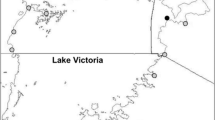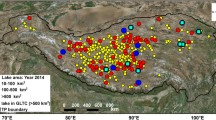Abstract
Lake monitoring by remote sensing is of significant importance to understanding the lake and ambient ecological and environmental processes. In particular, whether lake water storage variation could predict lake surfacial temperature or vice versa has long fascinated the research community, in that it would greatly benefit the monitoring missions and scientific interpretation of the lake change processes. This study attempted to remotely detect the dynamics of the Aral Sea and pursue the relationships between varying lake water storage attributes and surface water temperature by using MODIS LST (Moderate-resolution Imaging Spectroradiometer Land Surface Temperature) 8-day composite products, satellite altimeter data, and actual meteorological measurements. Their associations with lake Surface Water Temperatures (SWT) were then analyzed. Results showed the lake water surface areas and elevations of the North Aral Sea tended to increasing trend from 2001 (2793.0 km2, 13.6 m) to 2015 (6997.8 km2, 15.9 m), while those of the South Aral Sea showed a decreasing trend during 2001 (20 434.6 km2, 3.9 m) and 2015 (3256.1 km2, 0.9 m). In addition, the annual daytime and nighttime lake SWT both decreased in the North Aral Sea, while only the daytime SWT in the South Aral Sea exhibited an increase, indicating a rising deviation of diurnal temperatures in the South Aral Sea during the past 15 yr. Moreover, a lower correlation was found between variations in the daytime SWT and storage capacity in the South Aral Sea (R2 = 0.33; P < 0.05), no fair correlations were tested between lake water storage and daytime SWT in the North Aral Sea nor between lake water storage and nighttime SWT in either part of the sea. These results implied that climate change, if any at least during the research period, has no significant effects on lake dynamics over the two sectors of the Aral Sea with anthropogenic disturbances. However, climate change and human activities may overlap to explain complex consequences in the lake storage variations. Our results may provide a reference for monitoring the spatiotemporal variations of lakes, increasing understanding of the lake water storage changes in relation to the lake SWT, which may benefit the ecological management of the Aral Sea region, in the effort to face the likely threats from climate change and human activities to the region.
Similar content being viewed by others
References
Bai J, Chen X, Li J et al., 2011. Changes in the area of inland lakes in arid regions of central Asia during the past 30 years. Environmental Monitoring and Assessment, 178(1–4): 247–256. doi: 10.1007/s10661-010-1686-y
Boomer I, Wünnemann B, Mackay A W et al., 2009. Advances in understanding the late Holocene history of the Aral Sea region. Quaternary International, 194(1–2): 79–90. doi: 10.1016/j.quaint.2008.03.007
Cai X, Feng L, Hou X et al., 2016. Remote sensing of the water storage dynamics of large lakes and reservoirs in the Yangtze River Basin from 2000 to 2014. Scientific Reports, 6: 36405. doi: 10.1038/srep36405
Chen J L, Wilson C R, Tapley B D et al., 2017. Long-term and seasonal Caspian Sea level change from satellite gravity and altimeter measurements. Journal of Geophysical Research: Solid Earth, 122(3): 2274–2290. doi: 10.1002/2016JB013595
Cretaux J F, Letolle R, Bergé-Nguyen M, 2013. History of Aral Sea level variability and current scientific debates. Global and Planetary Change, 110: 99–113. doi: 10.1016/j.gloplacha.2013.05.006
Crosman E T, Horel J D, 2009. MODIS-derived surface tempera¬ture of the Great Salt Lake. Remote Sensing of Environment, 113(1): 73–81. doi: 10.1016/j.rse.2008.08.013
Dessler A E, Palm S P, Spinhirne J D, 2006. Tropical cloud-top height distributions revealed by the ice, cloud, and land eleva¬tion satellite (ICESat)/Geoscience laser altimeter system (GLAS). Journal of Geophysical Research: Atmospheres, 111(D12). doi: 10.1029/2005JD006705
Gafurov A, 2010. Water Balance Modeling Using Remote Sensing Information: Focus on Central Asia. Stuttgart: University of Stuttgart.
Gong P, 2012. Remote sensing of environmental changes over China: a review. Chinese Science Bulletin, 57: 2793–2801. doi: 10.1007/s11434-012-5268-y
Gorham E, 1964. Morphometric control of annual heat budgets in temperate lakes. Limnology and Oceanography, 9(4): 529–533. doi: 10.4319/lo.1964.9.4.0525
Hu Liangjun, Yang Haijun, Yang Qinke et al., 2010. A GIS-based modeling approach for fast assessment of soil erosion by water at regional scale, Loess Plateau. Chinese Geographical Sci¬ence, 20(5): 423–433. doi: 10.1007/s11769-010-0416-2
Huang X, Xie H, Liang T et al., 2011. Estimating vertical error of SRTM and map-based DEMs using ICESat altimetry data in the eastern Tibetan Plateau. International Journal of Remote Sensing, 32(18): 5177–5196. doi: 10.1080/01431161.2010.495092
Ke L H, Song C Q, 2014. Remotely sensed surface temperature variation of an inland saline lake over the central Qinghai–Tibet Plateau. ISPRS Journal of Photogrammetry and Remote Sensing, 98: 157–167. doi: 10.1016/j.isprsjprs.2014.09.007
Livingstone D M, Dokulil M T, 2001. Eighty years of spatially coherent Austrian lake surface temperatures and their rela¬tionship to regional air temperature and the North Atlantic Os¬cillation. Limnology and Oceanography, 46(5): 1220–1227. doi: 10.4319/lo.2001.46.5.1220
Luyssaert S, Jammet M, Stoy P C et al., 2014. Land management and land-cover change have impacts of similar magnitude on surface temperature. Nature Climate Change, 4: 389–393. doi: 10.1038/nclimate2196
McFeeters S K, 1996. The use of the Normalized Difference Wa¬ter Index (NDWI) in the delineation of open water features. International Journal of Remote Sensing, 17(7): 1425–1432. doi: 10.1080/01431169608948714
Micklin P, 2010. The past, present, and future Aral Sea. Lakes & Reservoirs: Research & Management, 15(3): 193–213. doi: 10.1111/j.1440-1770.2010.00437.x
Peneva E L, Stanev E V, Stanychni S V et al., 2004. The recent evolution of the Aral Sea level and water properties: analysis of satellite, gauge and hydrometeorological data. Journal of Marine Systems, 47(1–4): 11–24. doi: 10.1016/j.jmarsys.2003.12.005
Riordan B, Verbyla D, McGuire A D, 2006. Shrinking ponds in subarctic Alaska based on 1950–2002 remotely sensed im¬ages. Journal of Geophysical Research: Biogeosciences, 111(G4). doi: 10.1029/2005JG000150
Shi K, Zhang Y, Zhu G et al., 2015. Long-term remote monitoring of total suspended matter concentration in Lake Taihu using 250 m MODIS-Aqua data. Remote Sensing of Environment, 164: 43–56. doi: 10.1016/j.rse.2015.02.029
Shi K, Zhang Y, Zhang Y et al., 2019. Phenology of Phytoplankton Blooms in a Trophic Lake Observed from Long-term MODIS Data. Environmental Science & Technology, 53: 2324–2331. doi: 10.1021/acs.est.8b06887
Sima S, Ahmadalipour A, Tajrishy M, 2013. Mapping surface temperature in a hyper-saline lake and investigating the effect of temperature distribution on the lake evaporation. Remote Sensing of Environment, 136: 374–385. doi: 10.1016/j.rse.2013.05.014
Song K, Wang M, Du J et al., 2016. Spatiotemporal variations of lake surface temperature across the Tibetan Plateau using MODIS LST product. Remote Sensing, 8(10): 854. doi: 10.3390/rs8100854
Sun F, Sun W, Chen J et al., 2012. Comparison and improvement of methods for identifying waterbodies in remotely sensed imagery. International journal of Remote Sensing, 33(21): 6854–6875. doi: 10.1080/01431161.2012.692829
Wan Z, Zhang Y, Zhang Q et al., 2002. Validation of the land surface temperature products retrieved from terra moderate resolution imaging spectroradiometer data. Remote Sensing of Environment, 83(1–2): 163–180. doi: 10.1016/S0034-4257(02)00093-7
Wang J, Song C, Reager J T et al., 2018. Recent global decline in endorheic basin water storages. Nature geoscience, 11(12): 926. doi: 10.1038/NGEO2999
Wang X, Gong P, Zhao Y et al., 2013. Water-level changes in China’s large lakes determined from ICESat/GLAS data. Remote Sensing of Environment, 132: 131–144. doi: 10.1016/j.rse.2013.01.005
Wang X W, Cheng X, Li Z et al., 2012. Lake water footprints identification from time-series ICESat/GLAS data. IEEE Geoscience and Remote Sensing Letters, 9: 333–337. doi: 10.1109/LGRS.2011.2167495
Wang Z M, Song K S, Zhang B et al., 2009. Shrinkage and frag¬mentation of grasslands in the West Songnen Plain, China. Ag¬riculture, Ecosystems and Environment, 129: 315–324. doi: 10.1016/j.agee.2008.10.009
Xiao F, Ling F, Du Y et al., 2013. Evaluation of spatial-temporal dynamics in surface water temperature of Qinghai Lake from 2001 to 2010 by using MODIS data. Journal of Arid Land, 5(4): 452 464. doi: 10.1007/s40333-013-0188-5
Zhang G, Xie H, Kang S et al, 2011. Monitoring lake level changes on the Tibetan Plateau using ICESat altimetry data (2003–2009). Remote Sensing of Environment, 115(7): 1733–1742. doi: 10.1016/j.rse.2011.03.005
Zhang S, Gao H, Naz B S, 2014. Monitoring reservoir storage in South Asia from multisatellite remote sensing. Water Resources Research, 50(11): 8927 8943. doi: 10.1002/2014WR015829
Author information
Authors and Affiliations
Corresponding authors
Additional information
Foundation item: Under the auspices of State Special Funds for Research Infrastructure of China (No. 2015FY110500), National Natural Science Foundation of China (No. 41730104)
Rights and permissions
About this article
Cite this article
Mu, G., Chen, L., Hu, L. et al. Remote Detection of Varying Water Storage in Relation to Surfacial Temperature of Aral Sea. Chin. Geogr. Sci. 29, 741–755 (2019). https://doi.org/10.1007/s11769-019-1069-4
Received:
Accepted:
Published:
Issue Date:
DOI: https://doi.org/10.1007/s11769-019-1069-4




